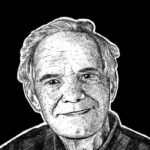Schema Therapy explained

Schema Therapy: this article explains Schema Therapy, developed by Jeffrey Young in a practical way. Next to what it is, this article also highlights what schemas are, the basic emotional needs, coping styles and why is schema therapy needed. After reading you will understand the basics of this form of therapy. Enjoy reading!
What is Schema Therapy?
Schema therapy is an internationally recognized form of therapy used in the treatment of personality disorders and other recurring long-term problems, such as anxiety and mood problems or disturbances in personal functioning.
Jeffrey Young
Developed by Jeffrey Young, this form of therapy is an integrative form of psychotherapy, which combines theory and techniques from other therapies.
Integrated therapies include cognitive behavioral therapy (CBT), psychoanalytic theories, and theories of Gestalt psychology.
Schema therapy encompasses four major theoretical concepts:
- Schemas
- Coping Styles
- Modes
- Basic Emotional Needs
These concepts are explained in practical terms in this article.
Schema Therapy: what are schemas?
In schema therapy, a schema refers specifically to a self-destructive pattern of emotions and physical sensations. These are often developed during childhood or adolescence and become more powerful as life goes on.
For example, a person who displays an abandonment schema may be hypersensitive to thoughts about their value to others, causing them to feel miserable and panicky in their relationships.
Schema therapy is for people who often react in the same, unwanted way to something or someone, when they intended to react differently. It can also be a certain thinking pattern. It is often described as a mental structure of preconceived ideas. Another word for these patterns is schemas.
There are several domains in which these schemas occur.
Disconnection / rejection
- Emotional deprivation
- Social isolation / alienation
- Defectiveness / shame
- Abandonment / instability
- Mistrust / abuse
Impaired autonomy and / or performance
- Dependence / incompetence
- Vulnerability to harm or illness
- Enmeshment / undeveloped self
- Failure
Impaired limits
- Entitlement / grandiosity
- Insufficient self-control and / or self-discipline
Other-directedness
- Subjugation
- Self-sacrifice
- Approval-seeking / Recognition-seeking
Overvigilance / inhibition
- Negativity / pessimism
- Emotional inhibition
- Punitiveness
- Hypercriticalness / Unrelenting standards
Schema Therapy and the Basic Emotional Needs
This dysfunction often stems from long-standing behavioral problems that bother someone or cause major problems. These often arise in childhood. If certain needs cannot be met, a person may develop schemas, coping styles, and modes.
A child with unmet needs for belonging, such as parental loss or addiction, may develop the abandonment schema.
The goal of schema therapy is to help patients meet their basic emotional needs by teaching them how to heal schemas.
Modes
Modes are states of mind that cluster schemas and coping styles into a temporary way of being. A person can switch to this. A vulnerable child may adopt a state of mind that includes schemas of abandonment, inadequacy, mistrust/abuse, and a surrender coping style.
Vulnerable child
A vulnerable child often feels lonely and isolated. Other emotions that a vulnerable child shows are:
- Sad
- Misunderstood
- Defective
- Robbed
- Not supported
- Overwhelmed
- Hopeless
- Afraid
- Anxious
- Worried
- Worthless
- Not loved
- Lost
- Directionless
- Fragile
- Weak
- Defeated
- Suppressed
- Powerless
- Left out
Angry child
An angry child often feels intensely angry or furious. The child becomes frustrated and impatient because the most important emotional needs of the vulnerable child cannot be met.
Impulsive child
An impulsive child often acts selfishly or uncontrollably on impulses to get his or her way. The child often feels angry, frustrated, impatient and seems spoiled because these emotions arise when they don’t get their way, after which sometimes they do.
Happy child
A happy child feels loved and content. Other emotions and traits that a happy child shows are:
- Connected
- Fulfilled
- Protected
- Accepted
- Validated
- Confident
- Competent
- Strong
- Resilient
- Safe
- Flexible
- Optimistic
- Spontaneous
- Self-reliant
- Autonomous
In addition to the above modes, there are 3 maladaptive coping modes, 2 maladaptive parent modes and a healthy adult mode.
Detached Protector
The detached protector emotionally disconnects from others and often rejects help. This person leads a secluded existence if possible and often feels empty or bored.
Time is mainly filled by engaging in compulsive or excessively distracting activities. You can recognize these people by their cynical and distant attitude towards the world and other people.
They will do everything they can to avoid contact or investing in other people.
Overcompensator
The overcompensator behaves in a remarkably aggressive and dominant manner. This person is highly competitive, arrogant, haughty, condescending, controlling and rebellious.
This person’s manipulative and exploitative tendency makes them unlovable. These feelings and behaviors were originally developed to compensate or satisfy unmet core needs.
The following two modes are maladaptive parent modes:
Punitive parent
The punitive parent believes that people deserve punishment or blame and acts on these feelings by blaming, punishing, or insulting themselves and others.
Demanding parent
The demanding parent believes that the only right way to live a life is to be perfect and perform at the highest level possible. Everything must be put aside while striving for high status. Be efficient and don’t waste time, that’s what the demanding parent likes to propagate.
Healthy Adult Mode
The healthy adult nurtures, validates, and affirms the vulnerable child. It also sets limits on the angry and impulsive child’s behavior and promotes and stimulates the healthy child mode. The healthy adult ensures that maladaptive coping modes are replaced and that the maladaptive parent modes are neutralized and moderated.
This person simultaneously performs appropriate functions such as a responsible job, parenting, and dedication. It also pursues pleasurable activities for adults: sports, cultural interests, sex, etc.
Schema therapy and Coping Styles
Coping styles are a person’s responses to schemas. There are three different coping styles:
- Avoidance
- Surrender
- Overcompensation / Counter attack
In avoidance, a person tries to avoid certain situations that trigger a schema. In surrender, a person gives in to a schema and does not try to fight it.
Behavior is changed in the expectation that the outcome is inevitable. In a counterattack, or overcompensation, a person goes to great lengths to prevent an outcome from happening. So it is actively fought against.
These coping styles often end in reinforcing the schemas.
Why is Schema Therapy Needed?
All people naturally have a tendency to strive for understanding, connection and growth. People are shaped by a deep desire to be seen, recognized and known.
The more that pursuit is thwarted by problems such as hardship, trauma, neglect, or loss, the deeper and more painful these desires become. Almost everyone has the need to grow and become the best version of themselves. With success, the result is happiness and vitality.
Schema therapy addresses the problems that arise when growth fails. As mentioned before, the goal is to help patients meet their basic emotional needs by teaching them how to heal schemas. It also teaches them to replace maladaptive coping styles with adaptive patterns of behavior.
Neuroscience has shown that humans have a built-in ability to grow and heal problems. A positive and responsive method ensures that chemicals and hormones are produced that regulate emotions, stress and unrest.
The brain’s ability to improve, coupled with the power of a therapeutic method, brings fulfillment and turns feelings of depression into a path of peace.
It’s Your Turn
What do you think? Do you recognize the explanation about Schema Therapy? Have you ever had therapy that used this method? Do you see similarities with other forms of therapy? What tips and comments can you share?
Share your experience and knowledge in the comments box below.
More information
- Young, J. E., Klosko, J. S., & Weishaar, M. E. (2003). Schema therapy. New York: Guilford, 254.
- Kellogg, S. H., & Young, J. E. (2006). Schema therapy for borderline personality disorder. Journal of clinical psychology, 62(4), 445-458.
- Hawke, L. D., & Provencher, M. D. (2011). Schema theory and schema therapy in mood and anxiety disorders: A review. Journal of cognitive psychotherapy, 25(4), 257-276.
- Jacob, G. A., & Arntz, A. (2013). Schema therapy for personality disorders—A review. International Journal of Cognitive Therapy, 6(2), 171-185.
How to cite this article:
Janse, B. (2022). Schema Therapy (Young). Retrieved [insert date] from Toolshero: https://www.toolshero.com/psychology/schema-therapy/
Original publication date: 08/25/2022 | Last update: 08/22/2023
Add a link to this page on your website:
<a href=”https://www.toolshero.com/psychology/schema-therapy/”>Toolshero: Schema Therapy (Young)</a>












